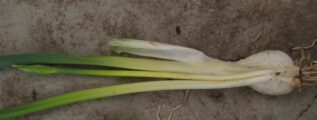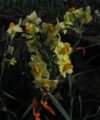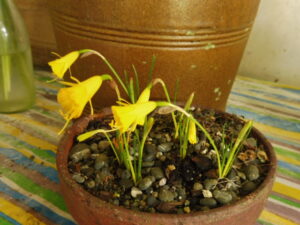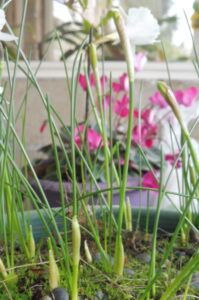A question put on Daffnet from Benjamin Whitacre about repeat flowering daffodils led to an interesting private correspondence. I have tried here to organise and add to my thoughts and observations from that exchange.
It is not uncommon for daffodils to produce secondary flowers. These are typically smaller and later.
I have a vague general impression that multiple flowering is most common in division 7. Certainly this is the case for me here in Canberra. Crossing fertile intersectional spring flowering jonquilla/fernandesii hybrids (eg. Limequilla) with autumn flowering viridiflorus hybrids (eg. Emerald Sea) seems to create enough confusion that some varieties flower more than once and with stems that are more equal. I didn’t originally breed for this characteristic but have started doing so.
In these varieties such a characteristic is only useful where there is a long season i.e. where the winters are mild and plants can grow throughout the winter. The winters here in Canberra are just a little too frosty for repeat flowering but one only needs to grow them against a sunny north wall (south wall in the Northern Hemisphere) and keep them watered.
The buds for spring flowering daffodils are formed toward the end of the previous spring’s growing season. If you use the technique of chipping or twin scaling, which is best done early summer, you can see the developing bud.
I don’t know when autumn flowering daffodils form their buds but presumably it is around the time they have finished seeding. It must happen well before the leaves die down.
There is a comment somewhere that tazettas can be raised from seed to flower in 18 months in artificial conditions. This means that tazettas can produce buds that flower without the plant going dormant.
If one bulb produces multiple flowers at the same time dissection of the bulb will show that each flower comes from a latent offset within the bulb, an offset that will in due course grow and split off from the main bulb.
This raises the question: – do secondary flowers also arise from their own offsets within the bulb?
19_03W was selected today from a long standing clump in the field. It is from seed planted in 2001.
It is a good doer in difficult conditions. Unusually, almost every bulb has an emerging secondary flower.
At the moment only one other variety at Yass, a paperwhite broussonetti hybrid, has a secondary flower, and in Canberra only one bulb of 10_01W (N. panizzianus – seed from Monocot) has one.
Dissection of the bulb makes it clear that the secondary flower comes from the same growth point as the primary flower and NOT from its own offset.
This makes sense of the multiple flowerings of 17_03MJ last year. But what 17_03MJ suggests is that, unlike 19_03W, subsequent stems can be of similar size and quality to the first stem.
Bill Welch has such vigorous tazettas that sometimes instead of a floret, a stem with further florets is produced. It would be interesting to know if there is a connection between multiple florets and multiple stems.
From a breeding perspective crossing 19_03W with the fertile intersectional jonquil/viridiflorus hybrids could be interesting.





Lawrence,
A couple of Dave’s theories in response to your interesting comments.
I often tell people that tazettas seem to have foliage almost 12 months of the year. Often people say ‘ Ah my daffodils are through the ground in early autumn.’ It is the tazettas.
I have the theory that multiple flowering is a survival mechanism in the species especially the romieuxii and the cantabricus. I often have three distinct sets of flowers, each about a fortnight apart from the same bulbs. I reason that if conditions aren’t suitable for setting seed with the first flowers then the second and third flowers are back ups to ensure at least one lot makes seed and the species survives.
Photos of N romieuxii albidus and Nb nivalis illustrating successive flowering as suggested above

I’m not sure how Lawrence’s photos got muddled up in here.
Hi Dave,
Thanks for pointing this out. As it happens, Gaddle Qua, bred from romieuxii, is flowering right now and is performing exactly as you describe. The bulb illustrates both a flower coming from an offset within the bulb and also a secondary flower coming from the same growing point as the main flower.
Further to my comments about succession flowering here are a couple of photos of Nylon flowering at the moment. A secondary flower bud, from the same bulb, is clearly evident. Picture quality is poor. Sorry my technical skills are very limited.
I repeat, I believe that the second and third flowers are there so that if conditions prevent pollination on the first flower then the sun might be shining a fortnight later.